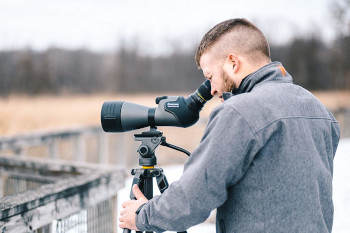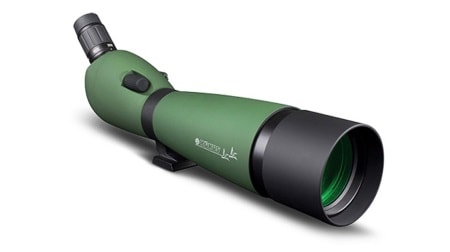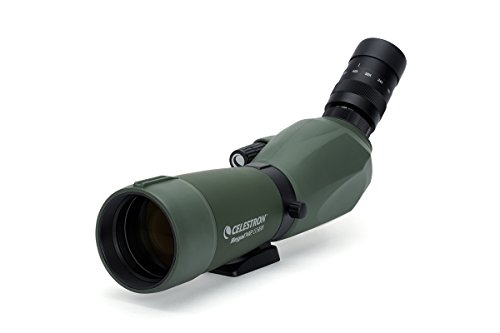5 Best Spotting Scopes under $500 in 2024 – Reviews & Top Picks
Last Updated on

There’s no way around it. Spotting scopes are expensive, and if you need one, you’re going to be shelling out hundreds or thousands of dollars.
Or, so they say. As it turns out, you can get a great spotting scope for less than $500, which will have many of the features that you’d expect on a more expensive model. Furthermore, image quality is good enough that you’ll wonder why you ever considered shelling out $1000 for a model that doesn’t provide a significantly better experience.
But, which model is right for you? It’s not always easy to shop online, and it’s not always obvious which features are superfluous, and which justify the price. That’s why we’ve compiled this list of reviews of some of the best spotting scopes under $500. We’ve also created a buyer’s guide to help you understand spotting scopes inside and out so that your next purchase is one that you love.
A Quick Look at Our Favorites (Updated in 2024)
| Image | Product | Details | ||
|---|---|---|---|---|
| Best Overall |
 |
Vortex Optics Diamondback |
|
CHECK PRICE |
 |
Celestron Regal M2 65ED |
|
CHECK PRICE | |
| Best Value |
 |
Konus 7122 |
|
CHECK PRICE |
 |
Vanguard Endeavor HD 82A |
|
CHECK PRICE | |
 |
Celestron C5 |
|
CHECK PRICE |
The 5 Best Spotting Scopes under $500
1. Vortex Diamondback Spotting Scope – Best Overall
The Vortex Optics Diamondback DBK-80A1 is our top spotting scope. In any spotting scope, you’re looking for the brightest and clearest images you can get, and this model delivers, with crystal-clear images and a brightness that you would only expect on a far more expensive scope. This model has the features you’ll need in a model that you’ll take outdoors frequently. It’s lightweight and compact, making it easy to move around, and it has a sturdy construction that will help it survive any bumps along the way.
It’s also waterproof and fog proof, which both protect the lenses from the elements, but also make sure that you always get the optimal viewing experience. The one downside to this model is that it provides a clear view out to about 200 yards. Beyond that point, you shouldn’t expect much out of this model. Overall, this is the best model for someone who wants a premium spotter without a premium price.
- Bright and clear images
- Lightweight and compact
- Durable construction
- Waterproof and fog proof
- Good to about 200 yards
See: Best Vortex Spotting Scopes
2. Celestron Regal M2 65ED Spotting Scope
The Celestron 52304 Regal M2 65 ED is our runner-up. It comes with an ED objective lens, or a lens rated for extra-low dispersion of light, which will produce higher-quality images with less color aberration. It’s rare to find ED lenses at this price point, so this model is already a great deal on that feature alone. It also comes with Celestron’s proprietary XTL coating that helps the mirrors reflect more light for a brighter final image.
The magnesium-allow body is designed to be durable, but also to be lighter than a similarly-designed aluminum frame. Unfortunately, this is still a very heavy spotting scope. It’s not heavy enough that you’ll have problems with it, but if you don’t already own a very strong tripod, you’ll probably have to upgrade yours to prevent sagging during use. If it weren’t for the fact that you needed a beastly tripod to make the most of this tripod, it would be higher on our list. As is, it’s a good purchase from an optical standpoint, and easily second-place on our list.
- ED objective lens
- XLT coatings
- Magnesium-alloy body
- Heavy
3. Konus 7122B Spotting Scope – Best Value

The Konus 7122B is our choice for best for the money. It comes with a smartphone adaptor, making it a spotting scope that’s ready for the modern age. If you want to shoot pictures with your smartphone, many of which come with great cameras today, then this is a great model for getting that extra zoom. It is also a lightweight scope, which makes it easy to move around and mount.
This model also comes with multi-coated optics, which reduce the amount of light lost during reflections, making for a brighter overall image, which is great for both viewing and taking pictures with your phone. While the price on this model is very good, if you’re looking to shoot with a camera that isn’t part of your smartphone, you’re going to have to shell out some extra money for an adapter. Overall, this is a fantastic deal if you want to take pictures with your phone using a scope, and decent value overall if you’re looking for a different experience.
- Comes with smartphone adaptor
- Lightweight
- Multicoated optics
- Poor camera integration
4. Vanguard Endeavor HD 82A Spotting Scopes
The best and worst thing about the Vanguard Endeavor HD 82A is that it works fine. If you buy this model, you won’t have many complaints or problems. It comes with ED glass, which makes it on the higher side quality-wise on our list and makes for better image quality. It also comes with a durable construction that makes it resistant to damage when accidentally dropped.
However, it’s one of the most expensive models on our list. As we said, it works well, but it lacks any features that would justify its price over some of the competition on this list. It’s poor value. You should either spend a bit more and jump up into the next tier of spotting scopes or spend a bit less and get the same performance out of a cheaper model. Despite working well, you’re not going to get the most bang for your buck when buying this model.
- ED glass
- Durable construction
- Expensive
- Poor value
5. Celestron C5 Spotting Scope
The first thing you need to know about the Celestron 52291 C5 is that it is a large monster of a spotting scope. It’s more of a telescope that Celestron decided to market as a spotting scope. Like many models that try to sit on the line between two product categories, it’s falls in that area where it does a decent job at both tasks but fails to be especially great in either. Furthermore, it’s so large that it’s not something that you’re going to want to take out into the field with you.
It does come with Celestron’s great XLT optical coating which improves brightness, but that’s where the upside ends. This model has suffered from more cost-cutting with each successive generation. The most recent variation doesn’t have great durability, and many people have to exchange the first model they order for a working one. You’ll never know what part will be loose or misshapen, which is the sign of unacceptable cost-cutting in manufacturing. If you need a dual-use spotting scope and telescope, this model might be worth a look, but you can probably get better value for less money with a different model.
- XLT optical coating
- Quality control problems
- Designed for astronomy
- Large
Buyers Guide: Choosing the Best Spotting Scope under $500
We hope that our reviews have given you some idea of what makes for a spotting scope with great value. If you’re still not sure which model is right for you, you should check out this buyer’s guide. It’s packed full of good information that will help you learn about spotting scopes and will help you figure out what you should be looking for when you go to buy.
Straight vs angled?
One of the first decisions you’re going to have to make when you’re shopping for a spotting scope is whether you want a straight scope or an angled scope. Most manufactures cast this as a feature that’s related to convenience. Because you can adjust the eyepiece, you can use an angled spotter scope in a lot of positions, and thus, it’s the more convenient scope.
That’s not the full story, however. Straight scopes are better for when you’re looking at something that is at the same height as you. If you start looking at things that are significantly higher or lower than you, you’re going to get some distortion. Angled scopes have more tolerance for things that are significantly higher or lower than you. While the convenience of an angled spotting scope is real, the lack of distortion due to height differences is far more significant.
One small plus to angled spotting scopes is that they often have the same levels of zoom in a slightly shorter length. They may be a hair taller, though, but overall, they tend to be a bit easier to store and are good for travel.
we discuss this topic in more detail here.
Zooms and lens sizes
Every spotting scope comes with a pair of numbers that tells you a lot about how the scope functions. They’ll usually look like “20×60” or “20-60×60.” The number before the “x” tells you what the zoom is. If there is only one number, then the spotting scope is fixed, or only able to show you an image at a single zoom. If the number is a range, like “20-60,” then the spotting scope enlarges the image 20 to 60 times before showing it to you and is variable to any value between 20 and 60.
Getting a spotting scope with a variable zoom gives you the flexibility that a fixed-zoom spotting scope does not.
The second number isn’t related to zoom, but to the size of the lens. If the second number is “60,” then the spotting scope has a lens that is 60 millimeters in diameter. The bigger the lens, the more light the spotting scope takes in, which means that your final images are more detailed and brighter. Furthermore, you may have a great zoom, but the total distance that you see is going to be limited by the size of your lens. Bigger is better here, and if you can get a model with a bigger lens for the same price as one with a smaller lens, you’d probably be better off getting the one with the bigger lens.
Lens and mirror coatings
Believe it or not, lenses and mirrors in their natural state don’t do a great job of focusing light. Lenses are prone to distorting different colors of light so that they don’t arrive at the correct focal point, which dramatically lowers the detail you can see. Mirrors in their natural state can cause brightness drops of up to 96% per mirror. The result in an untreated system is a dark, blurry image.
Modern designs make use of ED lenses and mirror coatings to solve these problems. ED lenses solve the splitting of light, or chromatic aberration by combing a low-dispersion and high-dispersion lens into a single unit to cancel out their effects, or by using chemicals on a single lens to produce the same effect.
Likewise, mirrors need a coating so that the glass protective coating absorbs as little light as possible. Different brands use different methods to accomplish this, but the best methods can achieve up to 83.5% reflection across the entire spectrum, which is a great improvement over the 4% you could expect from untreated mirrors.

Conclusion:
The Vortex Optics Diamondback DBK-80A1 is our top choice for the best spotting scope under $500, as it produces high-quality images and is durably built, all at a great price. The Celestron 52304 Regal M2 65 ED has a great ED lens but is heavy enough to drop to second place on our list. The Konus 7122B is our choice for best for the money due to its lightweight frame and its inclusion of a smartphone adaptor. The Vanguard Endeavor HD 82A works well but is too expensive relative to the value that it provides. The Celestron 52291 C5 is bulky and not specifically designed as a spotting scope, making it poor value for the price.
Hopefully, our reviews have helped you understand what makes for a great spotting scope. Armed with this knowledge, you should be able to find the scope that keeps you happily staring into the distance long into the future.
Looking for more spotting scope content? Try:
About the Author Robert Sparks
Robert’s obsession with all things optical started early in life, when his optician father would bring home prototypes for Robert to play with. Nowadays, Robert is dedicated to helping others find the right optics for their needs. His hobbies include astronomy, astrophysics, and model building. Originally from Newark, NJ, he resides in Santa Fe, New Mexico, where the nighttime skies are filled with glittering stars.
Related Articles:
How to Clean a Refractor Telescope: Step-by-Step Guide
How to Clean a Telescope Eyepiece: Step-by-Step Guide
How to Clean a Rifle Scope: 8 Expert Tips
Monocular vs Telescope: Differences Explained (With Pictures)
What Is a Monocular Used For? 8 Common Functions
How to Clean a Telescope Mirror: 8 Expert Tips
Brightfield vs Phase Contrast Microscopy: The Differences Explained
SkyCamHD Drone Review: Pros, Cons, FAQ, & Verdict







